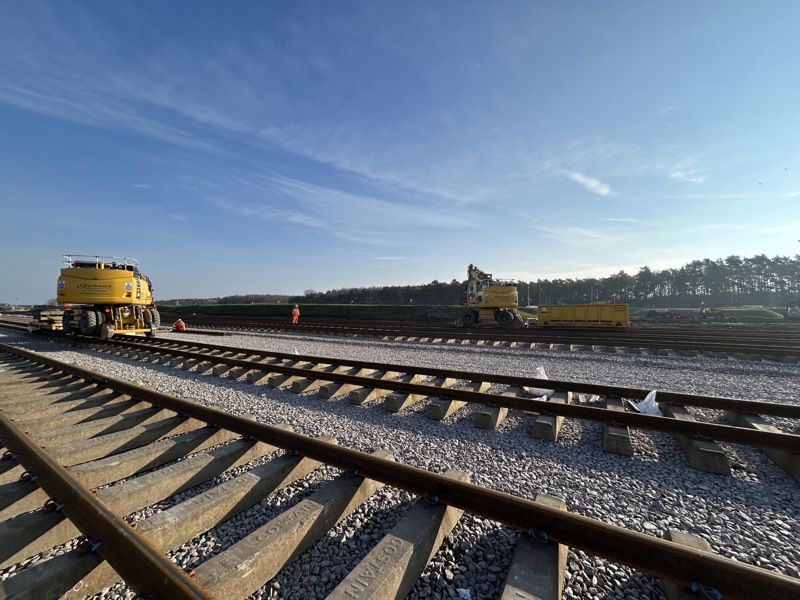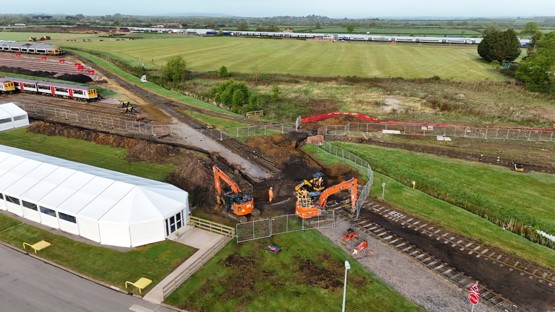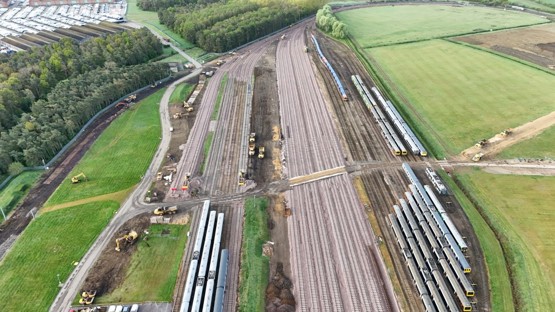
Construction is continuing at pace at Porterbrook’s Long Marston Rail Innovation Centre (RIC) as it installs its 3.5 kilometre (2.1 miles) electrified track.

Construction is continuing at pace at Porterbrook’s Long Marston Rail Innovation Centre (RIC) as it installs its 3.5 kilometre (2.1 miles) electrified track.
Work started in January as the team cleared much of the land on the internal loop to begin constructing and laying the electrified sidings before moving to complete the outer loop later this year.
The site once finished will have two electrified loops built. The outer loop will be able to handle train tests up to 50mph on a closed loop whilst an inner loop will also be completed that will allow for low-speed testing and storage. A chord will also carve through the site, connecting the inner and outer loops and provide access to the sidings.
Construction of the inner loop and sidings are close to being completed, with much of the new track due to be tamped over the coming months, before the cantilevers are erected and electrified over the summer months. Once that is in place, testing can begin.

However, Porterbrook’s Chief Operating Officer Ben Ackroyd told RAIL that it had been a “game of chess” over the last few months to move many of the currently stored units on the site in and out of the construction site.
Despite the challenges, he is excited at the potential for the finished site, “This site will really elevate our testing potential. It is a unique proposition for the industry, being a place for testing, technology and research and ultimately, given it is a closed loop circular test track, it means testing is uninhibited and continuous. That’s very exciting for us.”
Porterbrook plan on providing passive provision for European Train Control System (ETCS) on the site however Ackroyd added that it is likely that will only be installed if demand is needed in which Network Rail cannot meet in the future.
The appeal of the site which has cost £75m once it is finished will almost certainly be with new-build train testing according to Ackroyd.

“It’s the perfect place for new-build introductions. Ideally, an operator would want one new train coming in and one train going out, but the industry does not work like that. Long Marston can de-stress that process of testing on the network.
“Operators and manufacturers do not need to rely on booking paths at night and the other issues you see when testing on the network.”
Slightly way from the new track being laid, Siemens Mobility which has partnered with Porterbrook on the project has completed the installation of its Rapid Charge Converter (RCC). The RCC aims to tackle the challenge of providing enough electric charge to the main line, allowing for a 11kV charge to be converted into a 25Kv AC power supply.
Jon Humpherson Electrification Director for Siemens Mobility said that the RCC was potentially a gamechanger for electrification.

“It has multiple uses – from charging trains, dynamic charging and potentially introducing renewable energy into rail. Our installation here though can act as an independent power supply unit for the depot. That can ensure the site doesn’t take away from the grid any more than it needs.”
Siemens Mobility is currently in discussions with TransPennine Upgrade about installing an RCC at its new depot at Shipley near Leeds, where it believes its solution could save the project an estimated £10 million.
The RCC is a core part of Siemens battery bi-mode train offering which is based on its popular Desiro Verve. The company plans to build the units at its Goole plant, with some of the testing being completed at Long Marston.
Login to continue reading
Or register with RAIL to keep up-to-date with the latest news, insight and opinion.


















Login to comment
Comments
No comments have been made yet.